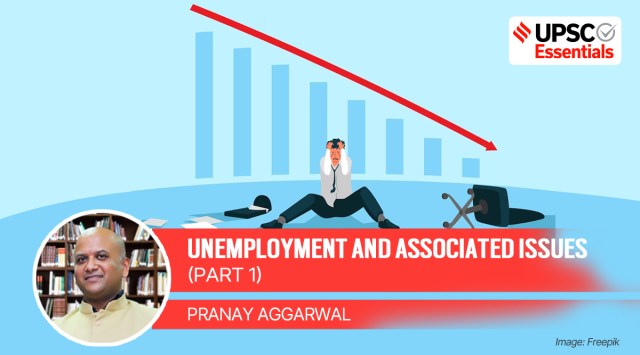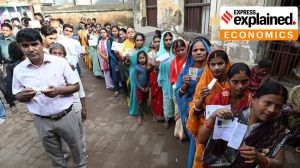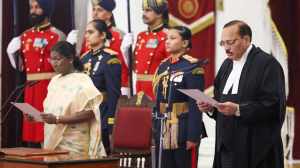Manas Srivastava leads the UPSC Essentials section of The Indian Express (digital). He majorly writes on UPSC, other competitive exams and education-related projects. In the past, Manas has represented India at the G-20 Youth Summit in Mexico. He is a former member of the Youth Council, GOI. A two-time topper/gold medallist in History (both in graduation and post-graduation) from Delhi University, he has mentored and taught UPSC aspirants for more than five years. His diverse role in The Indian Express consists of writing, editing, anchoring/ hosting, interviewing experts, and curating and simplifying news for the benefit of students. He hosts the YouTube talk show called ‘Art and Culture with Devdutt Pattanaik’ and a LIVE series on Instagram and YouTube called ‘LIVE with Manas’.His talks on ‘How to read a newspaper’ focus on newspaper reading as an essential habit for students. His articles and videos aim at finding solutions to the general queries of students and hence he believes in being students' editor, preparing them not just for any exam but helping them to become informed citizens. This is where he makes his teaching profession meet journalism. He is also the editor of UPSC Essentials' monthly magazine for the aspirants. He is a recipient of the Dip Chand Memorial Award, the Lala Ram Mohan Prize and Prof. Papiya Ghosh Memorial Prize for academic excellence. He was also awarded the University’s Post-Graduate Scholarship for pursuing M.A. in History where he chose to specialise in Ancient India due to his keen interest in Archaeology. He has also successfully completed a Certificate course on Women’s Studies by the Women’s Studies Development Centre, DU. As a part of N.S.S in the past, Manas has worked with national and international organisations and has shown keen interest and active participation in Social Service. He has led and been a part of projects involving areas such as gender sensitisation, persons with disability, helping slum dwellers, environment, adopting our heritage programme. He has also presented a case study on ‘Psychological stress among students’ at ICSQCC- Sri Lanka. As a compere for seminars and other events he likes to keep his orating hobby alive. His interests also lie in International Relations, Governance, Social issues, Essays and poetry. ... Read More
UPSC Essentials | Society and Social Justice : Unemployment and associated issues (Part 1)
What are the various aspects of unemployment that you shouldn't miss for your UPSC CSE? From basics to advance, our expert discusses probable questions and a key issue — why is unemployment among youth seen as a major problem today? Stay tuned for parts 2 and 3.
 "Addressing youth unemployment requires targeted policies that align education with market needs, foster entrepreneurship, and create an environment conducive to job creation in sectors appealing to the younger workforce," says Pranay Aggarwal.
"Addressing youth unemployment requires targeted policies that align education with market needs, foster entrepreneurship, and create an environment conducive to job creation in sectors appealing to the younger workforce," says Pranay Aggarwal.(In UPSC Essentials’ series ‘Society & Social Justice’, which we have started for social issues topics of UPSC CSE, our subject experts will give an overview of the theme from both, static and dynamic points of view. Our first four topics were ‘Population’ , ‘Urbanisation’, ‘Literacy’ and ‘Poverty’. For the month of March, we take up the topic of ‘Unemployment and associated issues’. In part 1, Manas Srivastava talks to Pranay Aggarwal about the basic concept, causes, measuring unemployment, unemployment scenario in our country, and more. Part 1 ends with an answer to a burning issue: Why is unemployment among youth seen as a major problem today? )
About the Expert: Pranay Aggarwal is an educator and mentor for aspirants preparing for UPSC Civil Services exam. With more than 10 years of experience guiding civil service aspirants, he is acknowledged as an expert on civil service exam preparation, especially on subjects like Social Issues and Sociology. He is the India representative on Research Committee on Education for UNESCO’s International Sociological Association and a member of Indian Sociological Society’s committee on social movements. He is also the Convenor of Indian Civil Services Association, a think tank of senior bureaucrats.
Relevance of the topic: The issue of employment has been at the heart of economic policy discussions, especially in recent decades when the link between economic growth and employment generation has social dimension too. This topic has various dimensions: factual – reflected through surveys, government reports and think tank data and analytical- based on experts’ analysis and debates revolving around them. One may have to make a note of important definitions and terminologies, data and changing trends along with connecting the dots with other related issues. It is an important theme in GS I (Society), GS II, GS III, Prelims and personality test. Aspirants will find it relevant for Essays as well.
Manas: Let us begin with the basics. What is unemployment or who is an unemployed person? Is unemployment synonymous with joblessness?
Pranay Aggarwal: Unemployment refers to the condition where individuals capable of working are actively seeking employment but are unable to secure suitable jobs. An unemployed person, then, is someone who is part of the labor force, possesses the requisite skills, but currently lacks gainful employment. Basically, an unemployed person is someone of working age, jobless, able and available to work, and actively looking for a job.
As per the International Labour Organisation’s definition, unemployment is based on the following three criteria which should be satisfied simultaneously: the “unemployed” comprise all persons above a specific age who are:
(a) without work (were not in paid employment or self-employed)
(b) currently available for work (were available for paid employment or self-employment during the reference period)
(c) seeking work (had taken specific steps in a specified reference period to seek paid employment or self-employment. It follows that an individual who has lost work but does not look for another job is not unemployed)
Thus, unemployment is not synonymous with joblessness.
Manas: Having answered the definition based question, the next logical question for any exam that follows is ‘How is unemployment measured?’
Pranay Aggarwal: The unemployment in the country is commonly calculated using the formula:
Unemployment rate = [Number of Unemployed Workers / Total Labour Force] x 100.
Story continues below this ad
Here, the ‘total labour force’ includes the employed and the unemployed. Those who are neither employed nor unemployed — students, for example— are not considered a part of the labour force.
In India, the National Statistical Office (NSO), which operates under the Ministry of Statistics and Programme Implementation, is tasked with officially assessing the unemployment rate. NSO has been conducting the Periodic Labour Force Survey (PLFS) since 2017 for this purpose. The PLFS estimates the key employment and unemployment indicators such as Worker Population Ratio, Labour Force Participation Rate and Unemployment Rate.
The NSO uses two significant measures for classifying the working status — the Usual Principal and Subsidiary Status (UPSS) and the Current Weekly Status (CWS). An individual’s principal status (UPSS) — whether employed, unemployed or out of the labour force — is based on the activity in which they “spent relatively long time” in the previous year. Current Weekly Status approach uses a much shorter reference period of a week. An individual is counted as being employed if they have worked for at least one hour on at least one day during the seven days preceding the date of survey. Logically, UPSS rates will be lower than CWS rates because there is a greater chance that a person will find work over a year as compared to a week.
The Centre for Monitoring Indian Economy (CMIE) is a private business information company whose unemployment data is also widely reported. CMIE classifies individuals based on their activity in the day preceding the interview. They, therefore, estimate a higher unemployment rate. The CMIE figures are, of course, not official figures endorsed by the government in the way PLFS survey data is.
An in-depth analysis of unemployment necessitates a consideration of various subcategories within the broader framework. Cyclical unemployment, for instance, is tied to economic cycles, escalating during downturns and abating during upswings. Understanding this facet offers insights into the macroeconomic forces influencing job availability.
Additionally, the concept of underemployment deserves attention. This occurs when individuals are employed in positions that underutilize their skills or provide insufficient working hours.
Examining underemployment alongside traditional measures provides a more nuanced comprehension of the quality and fulfillment of employment opportunities.
Furthermore, the measurement of unemployment is evolving with the advent of the gig economy. Traditional metrics may not fully capture the nuances of this contemporary work landscape, prompting a need for recalibration and adaptation. NITI Aayog has made recommendations to capture gig workers in the PLFS surveys. Integrating metrics like the gig economy participation rate can offer a more contemporary lens, acknowledging the diversity of employment arrangements in the modern era.
In summary, the measurement of unemployment is not a monolithic endeavor but a nuanced exploration of various dimensions. By considering a spectrum of indicators and recognizing the evolving nature of work, we can construct a more comprehensive narrative, empowering both policymakers and the public with a holistic understanding of the ever-shifting dynamics within the labor market.
Manas: Let us dive deep. What are the different types of unemployment, and why is it important to know about different forms?
Pranay Aggarwal: The spectrum of unemployment encompasses various types, each offering insights into different facets of the labor market.
● Structural Unemployment: Rooted in mismatches between the skills possessed by the workforce and the requirements of available positions, this form of unemployment highlights systemic issues within the labour market.
● Cyclical Unemployment: Tied to economic cycles, this type escalates during economic downturns and diminishes during periods of expansion, showcasing the sensitivity of job availability to macroeconomic conditions.
● Seasonal Unemployment: Occurring due to predictable fluctuations in demand based on seasons, this type affects various sectors of the economy such as agriculture and tourism, where employment needs vary with the time of year.
● Technological Unemployment: Driven by advancements in technology, this form results from automation and innovation leading to a reduced demand for certain manual or routine tasks, potentially displacing workers. It also occurs when people are not able to match up with the technology.
● Frictional Unemployment: Arising from the natural transition between jobs, this type reflects the temporary period individuals spend searching for new employment opportunities.
● Underemployment: While not strictly unemployment, this concept pertains to individuals employed in positions that underutilize their skills or provide insufficient working hours, contributing to a sense of economic inefficiency.
● Hidden Unemployment: Refers to individuals who are not actively seeking employment due to discouragement or other factors but could potentially enter the job market if conditions improve.
Understanding these various types of unemployment is crucial for formulating targeted policies and interventions that address the diverse challenges within the labour market.
Manas: The rate of unemployment in India has been one of the most talked about social and economic issue over the years. What is the unemployment scenario in our country?
Pranay Aggarwal: According to the PLFS Annual Report 2022- 2023, there is an overall encouraging scenario regarding employment, with Unemployment Rate falling from 6.0 per cent in 2017-18 to 3.2 per cent in 2022-23.
In rural areas, unemployment rate has reduced from 5.3 per cent in 2017-18 to 2.4 per cent in 2022-23 while for urban areas it declined from 7.7 per cent to 5.4 per cent during the same period. The unemployment rate for males in India reduced from 6.1 per cent in 2017-18 to 3.3 per cent in 2022-23 and that for female declined from 5.6 per cent to 2.9 per cent.
The unemployment scenario in India reflects a complex interplay of various factors. The unemployment rate has experienced fluctuations influenced by both structural and cyclical forces. Ongoing efforts are being made to address challenges associated with skill-mismatch, a noteworthy contributor to unemployment, through initiatives aimed at enhancing vocational training and aligning educational curricula with market demands.
The country also contends with informal employment, a significant aspect of the labour market. Tracking and addressing underemployment, particularly in the context of the expansive informal sector, is pivotal for a comprehensive evaluation of India’s employment landscape.
Furthermore, the emergence of the gig economy has introduced new dynamics, altering the traditional employment paradigm. Integrating this aspect into our understanding of unemployment provides a more contemporary and accurate portrayal of the employment scenario.
In essence, India’s unemployment scenario is multifaceted, reflecting the intricacies of a diverse and dynamic economy. It requires a nuanced approach that considers both traditional and evolving aspects of employment to formulate effective policies for sustained economic growth and equitable opportunities.
Manas: What, according to you, are the major causes of unemployment in India?
Pranay Aggarwal: The unemployment landscape in India is shaped by a confluence of factors, encompassing both structural and cyclical influences.
● Population size: India’s substantial population amplifies the competition for employment opportunities, putting additional pressure on the job market. Managing this demographic challenge necessitates a comprehensive approach to economic development and job creation.
● Skills mismatch: A predominant cause, where the skills possessed by the workforce may not align with the evolving demands of the job market. Addressing this issue requires initiatives focused on enhancing education and vocational training programs.
● Economic cycles: The cyclical nature of the economy contributes to fluctuations in job availability. Periods of economic downturns can lead to increased unemployment, highlighting the need for strategies that bolster resilience during economic contractions.
● Informal sectordynamics: The prevalence of the informal sector introduces complexities in tracking and addressing unemployment. Efforts to formalise and regulate this sector can contribute to a more accurate representation of employment conditions.
● Technological disruption: Rapid technological advancements can lead to displacement in certain industries, contributing to unemployment. Encouraging skill adaptation and fostering innovation in emerging sectors become crucial responses.
● Policy implementation challenges: Well-intentioned policies may face challenges in effective implementation, impacting their ability to generate employment. Streamlining policy execution and ensuring alignment with ground realities are imperative.
● Global economic factors: Influences from the global economy, such as trade dynamics and geopolitical shifts, can impact India’s employment scenario. Crafting policies that enhance economic resilience to external factors is essential.
In addressing these causes, a comprehensive and adaptive approach, considering both short-term and long-term strategies, is imperative for fostering sustainable employment opportunities in India.
Manas: The burning issue often seen in news headlines is ‘Unemployment and Youth’. Why is youth unemployment seen as a major problem today?
Pranay Aggarwal: Youth unemployment is a significant contemporary issue due to several interconnected factors:
● Demographic Pressures: India has a sizable youth population, leading to a surge in the number of individuals entering the job market. We are presently in the demographic dividend opportunity stage, and it is expected to last till about 2055. The mismatch between the demographic bulge and available employment opportunities intensifies competition and raises the stakes for young job seekers.
● Educational Expansion and Rising Expectations: As educational attainment rises, so do expectations for meaningful and well-compensated employment. The Gross Enrolment Ratio (GER) in higher education has already crossed 27 per cent. NEP 2020 targets 50 per cent GER by 2035. The gap between rising aspirations (due to better qualifications) and actual job availability can lead to frustration and disillusionment among youth.
● Technology Disruption: Rapid technological advancements can lead to the displacement of traditional jobs, affecting youth disproportionately as they often seek employment in sectors vulnerable to automation.
● Global Economic Dynamics: Global economic fluctuations and uncertainties can impact industries that traditionally absorb young workers, exacerbating youth unemployment during economic downturns.
● Delayed Entry into the Workforce: Factors such as pursuing higher education or taking time to explore diverse career paths can delay entry into the workforce. However, prolonged transitions can contribute to higher levels of youth unemployment.
● Skills Gap: Changes in the skills demanded by the job market and the skills possessed by recent graduates can result in a significant gap, making it challenging for youth to secure employment matching their qualifications.
● Social and Political Implications: High youth unemployment can have social and political repercussions, leading to disenchantment, demands for reservations and state benefits, social unrest, and potential challenges to political stability.
Addressing youth unemployment requires targeted policies that align education with market needs, foster entrepreneurship, and create an environment conducive to job creation in sectors appealing to the younger workforce.
The multifaceted nature of this issue underscores the importance of comprehensive strategies for sustainable solutions.
Manas: Before moving ahead, if you can suggest what should be read on unemployment?
Pranay Aggarwal: To gain a comprehensive understanding of unemployment, you can explore a variety of readings, including reports, books, and articles. Here are some recommended sources:
Reports and Research:
● World Employment and Social Outlook – Trends 2024 by ILO: This report by the International Labour Organization provides insights into global employment trends, including unemployment rates and challenges.
● Annual Report 2022-23 by Union Ministry of Labour & Employment: It captures the current scenario in Indian labour market well, including issues like child labour and women in the labour force. The report mentions key labour statistics, important constitutional and legal provisions, and various government policies and schemes.
● 2022 Discussion Paper on Workforce changes and Employment by NITI Aayog: It is a useful paper to understand basic employment related terms like Labour-Force-Participation Rate and Worker-to-Population Ratio; and also the major findings from the recent PLFS surveys.
● Employment and Self Employment (Special Issue) of Yojana magazine: It provides an overview of the employment scenario in the country and various related issues, in informative articles by leading economists, planners and bureaucrats.
● India’s Booming Gig and Platform Economy Report by NITI Aayog: This report presents a scientific framework for assessing the potential job creation in the gig-platform economy. It also offers comprehensive perspectives and recommendations concerning the gig economy in India.
Books:
● Employment in India (by Ajit K. Ghose): This book briefly traces the historical trends, current challenges, and future prospects of employment in India. It starts with the employment conditions during the country’s planned development, charting its evolution in connection with growth strategies, demographic shifts, and institutional changes. It also explores fundamental concepts like employment, unemployment, labor force and labor participation.
● Globalization, Labour Market Institutions, Processes and Policies in India (edited by K.R. Shyam Sundar): This book delves into the consequences of product market and labor market reforms on companies, labor institutions, and labor rights in India’s economy and industrial relations system. It also evaluates how labor market reforms affect both formal and informal labor markets in the country.
● Employment, Technology and Development (by Amartya Sen): Exploring the interconnectedness of institutions, technology, and labour market, this book examines how institutional factors influence policy making, including modes of production, ownership patterns, and employment.
These readings offer diverse perspectives on unemployment, covering economic theories, policy considerations, and real-world case studies.
Of course, civil services aspirants should be aware of the constraints on their time. They must consider the relative importance of topics in the exam syllabus and allocate study time accordingly. Therefore, UPSC aspirants should view the above mentioned resources as valuable, comprehensive, and reliable; but use them selectively. It is recommended to selectively explore a mix of reports, books, and articles to gain a well-rounded understanding of this complex topic.
In the upcoming parts on unemployment we shall focus on questions such as:
What are the various consequences of unemployment?
What have been some of the measures or policy initiatives taken to control unemployment?
Is AI going to be the new age cause of unemployment?
How does the global economy affect national employment?
‘Wages are the worry, not just unemployment.’ Discuss.
and many more points to ponder…
Previous topics on Society and Social Justice:
UPSC Essentials: Society & Social Justice | Population and associated issues (Part 1)
UPSC Essentials: Society & Social Justice | Population and associated issues (Part 2)
UPSC Essentials| Society & Social Justice — Urbanisation and associated issues (Part 1)
UPSC Essentials | Society & Social Justice : Urbanisation and associated issues (Part 2)
UPSC Essentials | Society & Social Justice : Urbanisation and associated issues (Part 3)
UPSC Essentials | Society & Social Justice : Literacy and associated issues (Part 1)
UPSC Essentials | Society & Social Justice : Literacy and associated issues (Part 2)
UPSC Essentials | Society & Social Justice : Literacy and associated issues (Part 3)
UPSC Essentials | Society & Social Justice : Poverty and associated issues (Part 1)
UPSC Essentials | Society & Social Justice : Poverty and associated issues (Part 2)
UPSC Essentials | Society & Social Justice : Poverty and associated issues (Part 3)
🚨 The Indian Express UPSC Essentials brings to you the February edition of its monthly magazine. Click Here to read. Share your views and suggestions in the comment box or at manas.srivastava@indianexpress.com🚨
The UPSC Essentials Indian Express is now on Telegram. Click here to join our YouTube channel and stay updated with the latest updates.
Share your views, answers and suggestions in the comment box or at manas.srivastava@indianexpress.com. You can also post your doubts, questions, and suggest themes on topics related to Society and Social Justice.
Subscribe to our UPSC Essentials newsletter : A weekly newsletter with important news, analysis, insights to help you prepare.
https://www.youtube.com/watch?v=25rAfDcDvrw?si=peR_oztcPW_Ew7pF
UPSC Magazine

Read UPSC Magazine



- 01
- 02
- 03
- 04
- 05




























